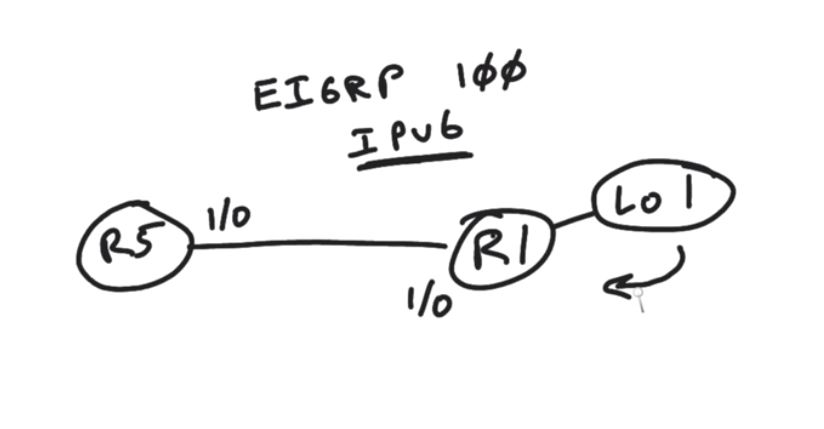Networking Basics: How to Implement EIGRP for IPv6

Let's take a look at the steps to implement EIGRP for IPv6 on two Cisco routers, R5 and R1, which are connected via the 1/0 fast ethernet interfaces. Using autonomous system 100, this process will implement EIGRP into the topology.

It's important to note that we'll be working exclusively with an IPv6 environment, with no IPv4 at any point. The topology will also add a loopback on R1. The IPv6 address of that loopback will then be advertised into the topology to ensure EIGRP is working. When that loopback appears on the R5, its presence will verify implementation.
How to Enable Unicast Routing Protocols
In the R5 command interface, enter global configuration mode and turn on "Unicast Routing Capabilities" for IPv6.
RouterR5# conf t
RouterR5(conf)# ipv6 unicast-routing
Creating an IPv6 Circuit on R5
Before implementing routing protocols, it's important to establish basic connectivity.
RouterR5(conf)# int fa1/0
RouterR5(conf-if)# ipv6 address 2001:51:51::5/64
RouterR5(conf-if)# no shut
The actual implementation would utilize the EUI-64 style of host addressing. EUI (Extended Unique Identifier) enables hosts to assign themselves unique 64-Bit IP Version 6 interface identifiers (EUI-64).
This provides an advantage over IPv4 — it eliminates the need for manual configuration or DHCP, which is required for IPv4. However, our example assigns the host portion of the address here for simplicity.
How to Configure R1
Now that the R5 has been set, open the R1 interface and input:
RouterR1# show ip int br
RouterR1# show ipv6 int br
These two commands will indicate that nothing is existing to interfere with the new implementation.
In the R1 command interface, enter global configuration mode and turn on 'Unicast Routing Capabilities' for IPv6.
RouterR1# conf t
RouterR1(conf)# ipv6 unicast-routing
Next, configure the fast ethernet 1/0 interface with an IPv6 address:
RouterR1(conf)# int fa1/0
RouterR1(conf-if)# ipv6 address 2001:51:51::1/64
RouterR1(conf-if)# no shut
Ping Test
The ping test verifies that Step 1 has been completed accurately. To do so, enter:
RotuerR1# ping 2001:51:51:5
This will ping the neighbor, R5, and should return a 100% success rate. This ping test confirms reachability in a routing protocol situation.
Creating the Loopback
Remaining in configuration for R1, configure a Loopback Interface for IPv6:
RouterR1(conf)# int lo 1
RouterR1(conf-if)# ipv6 address 2001:1:1::1/64
EIGRP for IPv6 Configuration
Recall that in IPv6, EIGRP is configured under interfaces, as there is no more network command as in IPv4. Configure EIGRP for IPv6 on Interface fa1/0 on Router1:
RouterR1# conf t
RouterR1(conf)# int fa1/0
RouterR1(conf-if)# ipv6 eigrp 100
Do the same for the Loopback Interface lo1:
RouterR1# conf t
RouterR1(conf)# int lo1
RouterR1(conf-if)# ipv6 eigrp 100
Verifying EIGRP and Disabling Shutdown
In the current setup, there will be no routing protocols running after this inquiry. The interfaces have been enabled, but are not active.
To solve this, we need to bring up EIGRP for IPv6 on Router1:
RouterR1# conf t
RouterR1(conf)# ipv6 router eigrp 100
RouterR1(conf-rtr)# no shutdown
By default, the shutdown is enabled. This is a vital step to avoid implementation failure.
Assigning a Router ID
To complete the configuration on Router, we need to assign a route ID.
RouterR1(conf-rtr)# eigrp-router-id 1.1.1.1
Finally, to check that all our changes were successful:
RouterR1# show ipv6 protocols
Replicating in R5
Now, we need to replicate the EIGRP setup on Router5:
RouterR5# conf t
RouterR5(conf)# int fa1/0
RouterR5(conf-if)# ipv6 eigrp 100
RouterR5(conf-if)# ipv6 router eigrp 100
RouterR5(conf)# int lo 1
RouterR5(conf-if)# ipv6 address 2001:1:1::5/64
RouterR5(conf-if)# ipv6 eigrp 100
RouterR5(conf-rtr)# no shutdown
RouterR5(conf-rtr)# eigrp-router-id 5.5.5.5
RotuerR5(conf-rtr)# no shut
To test with connectivity to Router1:
RouterR5# ping 2001:1:1::1
And finally, to check that process worked, in the both the R1 and R5 console, input:
RouterR1# show ipv6 protocols
RouterR5# show ipv6 protocols
This will confirm that EIGRP is actually running.
CBT Nuggets IPv6 Training
Trainer Keith Barker has created the following IPv6-specific training.
Anthony Sequeira, another CBT Nuggets trainer, discusses this topic more in depth right here.
delivered to your inbox.
By submitting this form you agree to receive marketing emails from CBT Nuggets and that you have read, understood and are able to consent to our privacy policy.